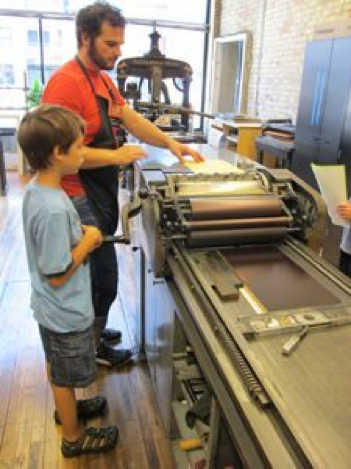The world's largest repository of Seals and Stamps
Today, a blog about printing and stamps will tell about the world's largest museum of book arts.
This Museum is located in the United States and is one of the most unique museums in the world. Minnesota Center for Book Arts is a recognized national leader in the preservation of traditional crafts, printing, printing coats of arms and stamps. The center regularly collaborates with both young and unknown artists and well-known artists. Stamps and seals are the pride of the Museum. The Museum traces a long tradition of stamp craft. The Museum exposition is based on 2 private collections of William "Picasso" Gaglione and Scott Helmes. Over 120 years of stamp collecting, the Museum's exhibition has expanded by more than 70,000 items. In addition, the Museum offers rare copies of magazines, books, posters...

According to the ideology of the Museum, the stamp is an important historical instrument of artistic expression. The Museum actively promotes the idea of using stamps not only for commercial purposes but also for cultural purposes, for this purpose lectures on the history of stamps are regularly organized, master classes that allow you to print yourself, as the Museum promotes the use of various stamps by artists in contemporary art.
In this exhibition, visitors can trace the appearance of the first seals and stamps, which began to appear only in 1851. At the seminars you can learn the detailed history of the stamp, first as a decoration of products, a few centuries ago, then as an important tool of trade and economic relations. Interestingly, the well-known rubber stamp appeared relatively recently, when in 1851 Charles Goodyear discovered the properties of vulcanization. He learned how to turn the viscous juice of South American rubber trees into hard rubber, it was a new turn in the development of stamp art.
The new method was innovative, easy, and economical, replacing lettering, stencils, and other types of printing. Soon the enterprises began to buy rubber stamps for marking of goods. It was great progress in printing and stamping.
Already in 1920, the Stamps began to be used in schools and other educational institutions. At first, it was cards and worksheets, which, for convenience, teachers created with the help of stamps. And in times of the great depression, stamps and did help the education system, when schools did not have the funds for new textbooks. Often the educational material of the entire course was created only with the help of stamps on handouts. For example, sets of stamps "The Story Printer" helped to create not only letters and words, but also numbers, mathematical expressions, images of objects, and illustrations, such as, for example, tractors and chickens.
Since the beginning of the 20th century, rubber stamps have been very popular among children and adolescents, the youth were decorated by stamping the walls, the ships of the train...We can safely say that the stamp painting became the progenitor of modern graffiti art.
Already in 1960, famous pop art artists turned their attention to stamps and their use in painting. For example, ray Johnson actively used stamps in his work.
Today, the process of creating stamps is digitized and optimized. There is nothing easier than to make a stamp yourself, using the online stamp maker on our website https://mystampready.com. With its help, you can build absolutely any sketch of the future print, whether it is a round print or any other, determine the size of the print, its shape, fullness, and you can use ready-made print stamp templates.
With the help of our website, You can order printing online, or just download the print, and if the stamp is needed urgently then we can buy the finished print and pick up at any place convenient for You.
More such stories, you can read in our blog! Develop, read, learn together with mystampready.com!
Date of publication 2019-08-12 05:06:53